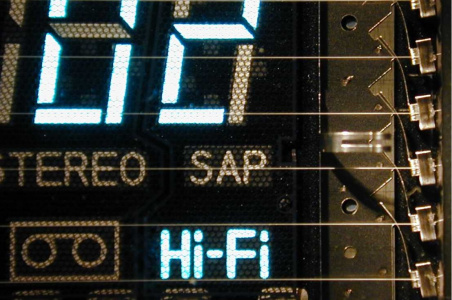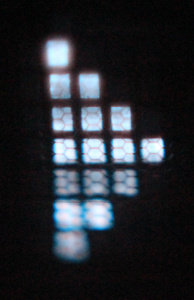Display types: Difference between revisions
m (→DIY) |
|||
| Line 542: | Line 542: | ||
https://www.buydisplay.com/download/ic/GC9A01A.pdf | https://www.buydisplay.com/download/ic/GC9A01A.pdf | ||
[[Category:Computer]] | |||
[[Category:Hardware]] | |||
=Flatscreen monitors= | |||
<!-- | |||
==Capabilities== | |||
===Resolution=== | |||
A TFT screen has a number of pixels, and therefore a natural resolution. Lower resolutions (and sometimes higher ones) can be displayed, but are interpolated so will not bee as sharp. Most people use the natural resolution. | |||
This may also be important for gamers, who may not want to be forced to a higher resolution for crispness than their graphics card can handle in terms of speed. | |||
For: | |||
* 17": 1280x1024 is usual (1280x768 for widescreen) | |||
* 19": 1280x1024 (1440x900 for widescreen) | |||
* 20": 1600x1200 (1680x1050 for widescreen) | |||
* 21": are likely to be 1600x1200 (1920x1200 for widescreen) | |||
Note that some screens are 4:3 (computer-style ratio), some 5:4 (tv ratio), some 16:9 or 16:10 (wide screen), but often not ''exactly'' that, pixelwise; many things opt for some multiple that is easier to handle digitally. | |||
===Refresh=== | |||
Refresh rates as they existed in CRT monitors do not directly apply; there is no line scanning going on anymore. | |||
Pixels are continuously lit, which is why TFTs don't seem to flicker like CRTs do. Still, they react only so fast to the changes in the intensity they should display at, which limits the amount of pixel changes that you will actually see per second. | |||
Longer refresh times mean moving images are blurred and you may see ghosting of brigt images. Older TFT/LCDs did something on the order of 20ms (roughly 50fps), which was is not really acceptable for gaming. | |||
However, the millisecond measure is nontrivial. The direct meaning of the number has been slaughtered primarily by number-boast-happy PR departments. | |||
More exactly, there are various things you can be measuring. It's a little like the speaker rating (watt RMS, watt 'in regular use', PMPO) in that a rating may refer unrealistic exhaggerations as well as strict and real measures. | |||
The argument is that even when the time for a pixel to be fully off to fully on may take 20ms, not everyone is using their monitor to induce epileptic attacks - usually the pixel is done faster, going from some grey to some grey. If you play the DOOM3 dark-room-fest, you may well see the change from that dark green to that dark blue happen in 8ms (not that that's in any way easy to measure). | |||
But a game with sharp contrasts may see slower, somewhat blurry changes. | |||
8ms is fairly usual these days. Pricier screens will do 4ms or even 2ms, which is nicer for gaming. | |||
===Video noise=== | |||
===Contrast=== | |||
The difference between the weakest and strongest brightness it can display. 350:1 is somewhat minimal, 400:1 and 500:1 are fairly usual, 600:1 and 800:1 are nice and crisp. | |||
===Brightness=== | |||
The amount of light emitted - basically the strength of the backlight. Not horribly interesting unless you like it to be bright in even a well lit room. | |||
300 cd/m2 is fairly usual. | |||
There are details like brightness uniformity - in some monitors, the edges are noticably darker when the screen is bright, which may be annoying. Some monitors have stranger shapes for their lighting. | |||
Only reviews will reveal this. | |||
===Color reproduction=== | |||
The range of colors a monitor can reproduce is interesting for photography buffs. The curve of how each color is reproduced is also a little different for every monitor, and for some may be noticeably different from others. | |||
This becomes relevant when you want a two-monitor deal; it may be hard to get a CRT and a TFT the same color, as much as it may be hard to get two different TFTs from the same manufacturer consistent. If you want perfection in that respect, get two of the same - though spending a while twiddlign with per-channel gamma correction will usually get decent results. | |||
==Convenience== | |||
===Viewing angle=== | |||
The viewing angle is a slightly magical figure. It's probably well defined in a test, but its meaning is a little elusive. | |||
Basically it indicates at which angle the discoloration starts being noticeable. Note that the brightness is almost immediately a little off, so no TFT is brilliant to show photos to all the room. The viewing angle is mostly interesting for those that have occasional over-the-shoulder watchers, or rather watchers from other chairs and such. | |||
The angle, either from a perpendicular line (e.g. 75°) or as a total angle (e.g. 150°). | |||
As noted, the figure is a little magical. If it says 178° the colors will be as good as they'll be from any angle, but frankly, for lone home use, even the smallest angle you can find tends to be perfectly fine. | |||
===Reflectivity=== | |||
While there is no formal measure for this, you may want to look at getting something that isn't reflective. If you're in an office near a window, this is probably about as important to easily seeing your screen as its brightness is. | |||
It seems that many glare filters will reduce your color fidelity, though. | |||
--> | |||
[[Category:Computer]] | [[Category:Computer]] | ||
[[Category:Hardware]] | [[Category:Hardware]] | ||
Revision as of 19:00, 29 March 2024
Backlit flat-panel displays
CCFL or LED backlight
https://nl.wikipedia.org/wiki/CCFL
Self-lit
OLED
QLED
On image persistence / burn-in
VFD
-
larger segments
-
dot matrix VFD
Vacuum Fluorescent Displays are vacuum tubes applied in a specific way - see Lightbulb_notes#VFDs for more details.
Lighting
Nixie tubes

Mechanical
Mechanical counter
https://en.wikipedia.org/wiki/Mechanical_counter
Split-flap

https://en.wikipedia.org/wiki/Split-flap_display
LED segments
7-segment and others

These are really just separate lights that happen to be arranged in a useful shape.
Very typically LEDs (with a common cathode or anode), though similar ideas are sometimes implemented in other display types - notably the electromechanical one, also sometimes VFD.
Even the simplest, 7-segment LED involves a bunch of connectors so are
- often driven multiplexed, so only one of them is on at a time.
- often done via a controller that handles that multiplexing for you
Seven segments are the minimal and classical case,
good enough to display numbers and so e.g. times, but not really for characters.
More-than-7-segment displays are preferred for that.
https://en.wikipedia.org/wiki/Seven-segment_display
DIY
LCD character dislays
Character displays are basically those with predefined (and occasionally rewritable) fonts.
Classical interface
The more barebones interface is often a 16 pin line with a pinout like
- Ground
- Vcc
- Contrast
- usually there's a (trim)pot from Vcc, or a resistor if it's fixed
- RS: Register Select (character or instruction)
- in instruction mode, it receives commands like 'clear display', 'move cursor',
- in character mode,
- RW: Read/Write
- tied to ground is write, which is usually the only thing you do
- ENable / clk (for writing)
- 8 data lines, but you can do most things over 4 of them
- backlight Vcc
- Backlight gnd
The minimal, write-only setup is:
- tie RW to ground
- connect RS, EN, D7, D6, D5, and D4 to digital outs
I2C and other
Matrix displays
(near-)monochrome
SSD1306
OLED, 128x64@4 colorsTemplate:Vierfy
https://cdn-shop.adafruit.com/datasheets/SSD1306.pdf
SH1107
OLED,
https://datasheetspdf.com/pdf-file/1481276/SINOWEALTH/SH1107/1
Small LCD/TFTs / OLEDs
Small as in order of an inch or two (because the controllers are designed for a limited resolution?(verify)).
and some of the ebays and aliexpresses sellers of the world will happily 'accidentally' call any small screen OLED if it means they sell more.
This is further made more confusing by the fact that there are
- few-color OLEDs (2 to 8 colors or so, great for high contrast but only high cotnrast),
- high color OLEDs (65K),
...so you sometimes need to dig into the tech specs to see the difference between high color LCD and high color OLED.
When all pixels are off they give zero light pollution (unlike most LCDs) which might be nice in the dark. These seem to appear in smaller sizes than small LCDs, so are great as compact indicators.
Can it do video or not?
If it does speak e.g. MIPI it's basically just a monitor, probably capable of decent-speed updates, but also the things you can connect to will (on the scale of microcontroller to mini-PC) be moderately powerful, e.g. a raspberry.
But the list below don't connect PC video cables.
Still, they have their own controller, and can hold their pixel state one way or the other, but connect something more command-like - so you can update a moderate amount of pixels with via an interface that is much less speedy or complex.
You might get reasonable results over SPI / I2C for a lot of e.g. basic interfaces and guages. By the time you try to display video you have to think about your design more.
For a large part because amount of pixels to update times the rate of frames per second has to fit through the communication (...also the display's capabilities). There is a semi-standard parallel interface that might make video-speed things feasible. This interface is faster than the SPI/I2C option, though not always that much, depending on hardware details.
Even if the specs of the screen can do it in theory, you also have to have the video ready to send.
If you're running it from an RP2040 or ESP32, don't expect to libav/ffmpeg.
Say, something like the TinyTV runs a 216x135 65Kcolor display from a from a RP2040.
Also note that such hardware won't be doing decoding and rescaling arbitrary video files. They will use specifically pre-converted video.
In your choices, also consider libraries.
Things like TFT_eSPI has a compatibility list you will care about.
Interfaces
ST7735
LCD, 132x162@16bits RGB
ST7789
LCD, 240x320@16bits RGB
https://www.waveshare.com/w/upload/a/ae/ST7789_Datasheet.pdf
SSD1331
OLED, 16bits RGB https://cdn-shop.adafruit.com/datasheets/SSD1331_1.2.pdf
SSD1351
OLED, 65K color
https://newhavendisplay.com/content/app_notes/SSD1351.pdf
HX8352C
LCD https://www.ramtex.dk/display-controller-driver/rgb/hx8352.htm
HX8357C
R61581
ILI9163
LCD, 162x132@16-bit RGB
http://www.hpinfotech.ro/ILI9163.pdf
ILI9341
https://cdn-shop.adafruit.com/datasheets/ILI9341.pdf
ILI9486
LCD, 480x320@16-bit RGB
https://www.hpinfotech.ro/ILI9486.pdf
ILI9488
LCD
https://www.hpinfotech.ro/ILI9488.pdf
PCF8833
LCD, 132×132 16-bit RGB
https://www.olimex.com/Products/Modules/LCD/MOD-LCD6610/resources/PCF8833.pdf
SEPS225
LCD
https://vfdclock.jimdofree.com/app/download/7279155568/SEPS225.pdf
RM68140
LCD
https://www.melt.com.ru/docs/RM68140_datasheet_V0.3_20120605.pdf
GC9A01 (round)
LCD, 65K colors, SPI
https://www.buydisplay.com/download/ic/GC9A01A.pdf

